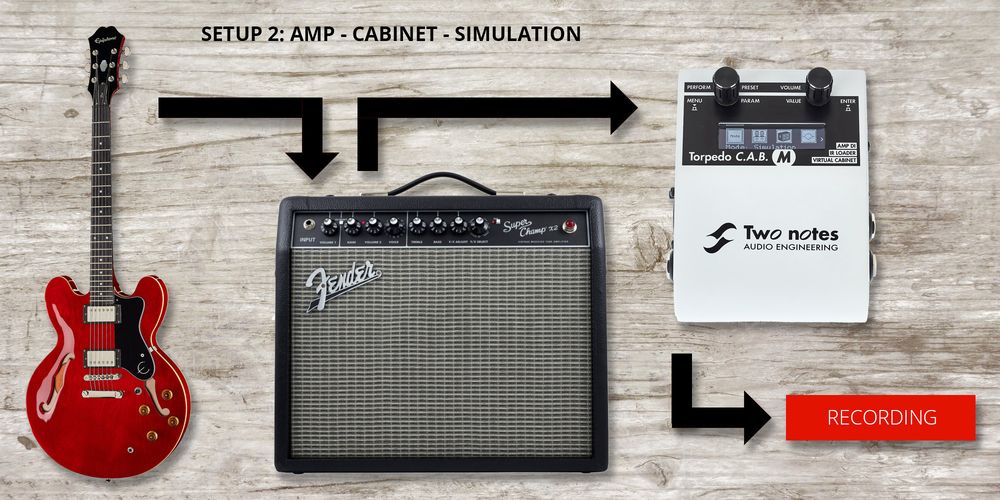6. Setup 2: Amp - Cab - Simulation
If you want to record your beloved tube amp without the hassle of setting up mics, searching for the perfect room, or dealing with other similar tasks, then the Cab Simulator is the alternative. The Cab Simulator, also known as Speaker Simulator, connects to the speaker output of your guitar amplifier. It digitally simulates a microphone-recorded guitar speaker, providing a finished signal that can be directly recorded. No need for a space for a loud guitar box, and you can even record quietly, like using headphones. Also, the recorded sounds are always reproducible. With a miked cab, there's always the risk of accidentally changing the microphone's position. In traditional recording setups, the sound remains consistent only if the mic and box setup remains untouched, which isn't always practical. Even slight changes in mic placement can affect the sound, as you've heard in previous examples. These issues don't exist with Cab Simulation, as many of these devices allow you to save and recall settings.

Amp - Cab - Simulation
Cab Simulators have been around for a while. The early models had analogue circuits and a more or less high-quality equalizer that usually cut the high frequencies. A guitar speaker typically has a limited frequency range, averaging from about 75Hz to 6kHz. To simulate this sound, the early Cab Simulators cut the highs above 6kHz. It's understandable that this method couldn't fully replicate the sound of a mic'd cab. However, everything changed with the introduction of digital technology, which significantly improved speaker simulations, bringing them closer to the real thing. Today, complex digital measurements analyze the speaker's tonal behavior, the sound alteration through the microphone, and the room's sound, replicating these during playback. These measurements are called Impulse Responses (IRs), serving as the basis for Cab Simulation. Some Cab Simulator manufacturers use specially created IRs, while others allow IRs from third-party providers to be loaded into the simulator. Leading devices come from brands like Two Notes, such as the flagship Torpedo or the more affordable Torpedo Captor X, as well as the Universal Audio OX. These devices can load simulations of various speaker cabinets and microphone types, allowing for combinations of at least two microphones and even room sounds. Here are four examples with the Marshall Plexi (same guitar and amp settings used in the mic'd signals) and a Universal Audio OX.
Ox Marshall Cab SM-57
OX Marshall Cab MD-421
OX Marshall Cab Neumann
OX Marshall Cab SM-57 und M160
One crucial consideration when using Cab Simulators: If you want to record without a speaker box entirely, make sure the device has a so-called load resistor (Loadbox function, Dummy Load) that replaces the speaker box and absorbs the entire power from the amp, converting it into heat. A tube amp must always be connected to a speaker box or a load resistor at the speaker output; otherwise, the amp could get damaged with prolonged use without a load. If the Cab Simulator doesn't have a load resistor, then to use it without a speaker box, an external load box should be connected between the amp and Cab Simulator. Suitable for this purpose are Power Attenuators with Loadbox function. In our product descriptions of Power Attenuators, you'll find under "More Information" whether the attenuator has a Dummy Load function.



